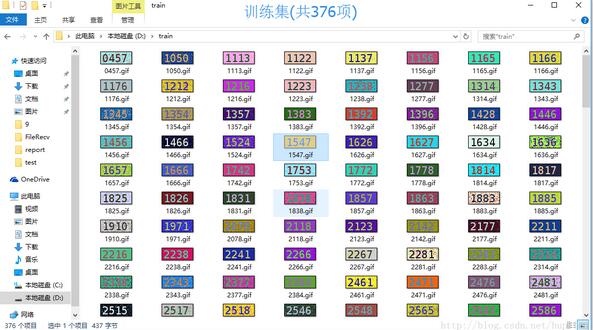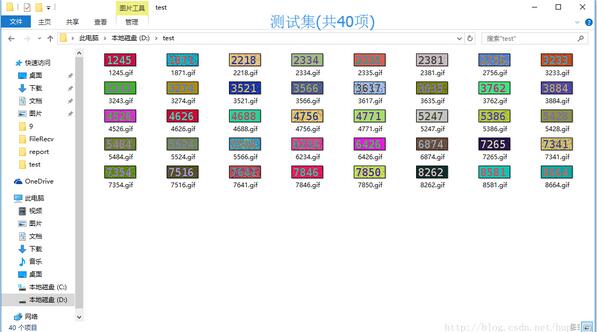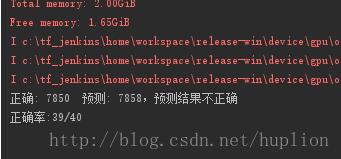简单的Tensorflow验证码识别应用,供大家参考,具体内容如下
1.Tensorflow的安装方式简单,在此就不赘述了.
2.训练集训练集以及测试及如下(纯手工打造,所以数量不多):


3.实现代码部分(参考了网上的一些实现来完成的)
main.py(主要的神经网络代码)
|
1
2
3
4
5
6
7
8
9
10
11
12
13
14
15
16
17
18
19
20
21
22
23
24
25
26
27
28
29
30
31
32
33
34
35
36
37
38
39
40
41
42
43
44
45
46
47
48
49
50
51
52
53
54
55
56
57
58
59
60
61
62
63
64
65
66
67
68
69
70
71
72
73
74
75
76
77
78
79
80
81
82
83
84
85
86
87
88
89
90
91
92
93
94
95
96
97
98
99
100
101
102
103
104
105
106
107
108
109
110
111
112
113
114
115
116
117
118
119
120
121
122
123
124
125
126
127
128
129
130
131
132
133
134
135
136
137
138
139
140
141
142
143
144
145
146
147
148
149
150
151
152
153
154
155
156
157
158
159
160
161
162
163
164
165
166
167
168
169
170
171
172
173
174
175
176
177
178
179
180
181
182
183
184
185
186
187
188
189
190
191
192
193
194
195
196
197
198
199
200
201
202
203
204
205
206
207
208
209
210
211
212
213
214
215
216
217
218
219
220
221
222
223
224
225
226
227
228
229
230
231
232
233
234
235
236
237
238
|
from gen_check_code import gen_captcha_text_and_image_new,gen_captcha_text_and_imagefrom gen_check_code import numberfrom test_check_code import get_test_captcha_text_and_imageimport numpy as npimport tensorflow as tftext, image = gen_captcha_text_and_image_new()print("验证码图像channel:", image.shape) # (60, 160, 3) # 图像大小 IMAGE_HEIGHT = image.shape[0]IMAGE_WIDTH = image.shape[1]image_shape = image.shapeMAX_CAPTCHA = len(text)print("验证码文本最长字符数", MAX_CAPTCHA) # 验证码最长4字符; 我全部固定为4,可以不固定. 如果验证码长度小于4,用'_'补齐# 把彩色图像转为灰度图像(色彩对识别验证码没有什么用)# 度化是将三分量转化成一样数值的过程def convert2gray(img): if len(img.shape) > 2: gray = np.mean(img, -1) # 上面的转法较快,正规转法如下 # r, g, b = img[:,:,0], img[:,:,1], img[:,:,2] # gray = 0.2989 * r + 0.5870 * g + 0.1140 * b # int gray = (int) (0.3 * r + 0.59 * g + 0.11 * b); return gray else: return img""" cnn在图像大小是2的倍数时性能最高, 如果你用的图像大小不是2的倍数,可以在图像边缘补无用像素。 np.pad(image,((2,3),(2,2)), 'constant', constant_values=(255,)) # 在图像上补2行,下补3行,左补2行,右补2行 """char_set = number # 如果验证码长度小于4, '_'用来补齐CHAR_SET_LEN = len(char_set)# 文本转向量def text2vec(text): text_len = len(text) if text_len > MAX_CAPTCHA: raise ValueError('验证码最长4个字符') vector = np.zeros(MAX_CAPTCHA * CHAR_SET_LEN) def char2pos(c): try: k = ord(c)-ord('0') except: raise ValueError('No Map') return k for i, c in enumerate(text): idx = i * CHAR_SET_LEN + char2pos(c) vector[idx] = 1 return vector# 向量转回文本def vec2text(vec): char_pos = vec.nonzero()[0] text = [] for i, c in enumerate(char_pos): char_at_pos = i # c/63 char_idx = c % CHAR_SET_LEN if char_idx < 10: char_code = char_idx + ord('0') elif char_idx < 36: char_code = char_idx - 10 + ord('A') elif char_idx < 62: char_code = char_idx - 36 + ord('a') elif char_idx == 62: char_code = ord('_') else: raise ValueError('error') text.append(chr(char_code)) return "".join(text)# 生成一个训练batchdef get_next_batch(batch_size=128): batch_x = np.zeros([batch_size, IMAGE_HEIGHT * IMAGE_WIDTH]) batch_y = np.zeros([batch_size, MAX_CAPTCHA * CHAR_SET_LEN]) # 有时生成图像大小不是(60, 160, 3) def wrap_gen_captcha_text_and_image(): while True: text, image = gen_captcha_text_and_image_new() if image.shape == image_shape: return text, image for i in range(batch_size): text, image = wrap_gen_captcha_text_and_image() image = convert2gray(image) batch_x[i, :] = image.flatten() / 255 # (image.flatten()-128)/128 mean为0 batch_y[i, :] = text2vec(text) return batch_x, batch_y####################################################################X = tf.placeholder(tf.float32, [None, IMAGE_HEIGHT * IMAGE_WIDTH])Y = tf.placeholder(tf.float32, [None, MAX_CAPTCHA * CHAR_SET_LEN])keep_prob = tf.placeholder(tf.float32) # dropout# 定义CNNdef crack_captcha_cnn(w_alpha=0.01, b_alpha=0.1): x = tf.reshape(X, shape=[-1, IMAGE_HEIGHT, IMAGE_WIDTH, 1]) # w_c1_alpha = np.sqrt(2.0/(IMAGE_HEIGHT*IMAGE_WIDTH)) # # w_c2_alpha = np.sqrt(2.0/(3*3*32)) # w_c3_alpha = np.sqrt(2.0/(3*3*64)) # w_d1_alpha = np.sqrt(2.0/(8*32*64)) # out_alpha = np.sqrt(2.0/1024) # 定义三层的卷积神经网络 # 定义第一层的卷积神经网络 # 定义第一层权重 w_c1 = tf.Variable(w_alpha * tf.random_normal([3, 3, 1, 32])) # 定义第一层的偏置 b_c1 = tf.Variable(b_alpha * tf.random_normal([32])) # 定义第一层的激励函数 conv1 = tf.nn.relu(tf.nn.bias_add(tf.nn.conv2d(x, w_c1, strides=[1, 1, 1, 1], padding='SAME'), b_c1)) # conv1 为输入 ksize 表示使用2*2池化,即将2*2的色块转化成1*1的色块 conv1 = tf.nn.max_pool(conv1, ksize=[1, 2, 2, 1], strides=[1, 2, 2, 1], padding='SAME') # dropout防止过拟合。 conv1 = tf.nn.dropout(conv1, keep_prob) # 定义第二层的卷积神经网络 w_c2 = tf.Variable(w_alpha * tf.random_normal([3, 3, 32, 64])) b_c2 = tf.Variable(b_alpha * tf.random_normal([64])) conv2 = tf.nn.relu(tf.nn.bias_add(tf.nn.conv2d(conv1, w_c2, strides=[1, 1, 1, 1], padding='SAME'), b_c2)) conv2 = tf.nn.max_pool(conv2, ksize=[1, 2, 2, 1], strides=[1, 2, 2, 1], padding='SAME') conv2 = tf.nn.dropout(conv2, keep_prob) # 定义第三层的卷积神经网络 w_c3 = tf.Variable(w_alpha * tf.random_normal([3, 3, 64, 64])) b_c3 = tf.Variable(b_alpha * tf.random_normal([64])) conv3 = tf.nn.relu(tf.nn.bias_add(tf.nn.conv2d(conv2, w_c3, strides=[1, 1, 1, 1], padding='SAME'), b_c3)) conv3 = tf.nn.max_pool(conv3, ksize=[1, 2, 2, 1], strides=[1, 2, 2, 1], padding='SAME') conv3 = tf.nn.dropout(conv3, keep_prob) # Fully connected layer # 随机生成权重 w_d = tf.Variable(w_alpha * tf.random_normal([1536, 1024])) # 随机生成偏置 b_d = tf.Variable(b_alpha * tf.random_normal([1024])) dense = tf.reshape(conv3, [-1, w_d.get_shape().as_list()[0]]) dense = tf.nn.relu(tf.add(tf.matmul(dense, w_d), b_d)) dense = tf.nn.dropout(dense, keep_prob) w_out = tf.Variable(w_alpha * tf.random_normal([1024, MAX_CAPTCHA * CHAR_SET_LEN])) b_out = tf.Variable(b_alpha * tf.random_normal([MAX_CAPTCHA * CHAR_SET_LEN])) out = tf.add(tf.matmul(dense, w_out), b_out) # out = tf.nn.softmax(out) return out# 训练def train_crack_captcha_cnn(): # X = tf.placeholder(tf.float32, [None, IMAGE_HEIGHT * IMAGE_WIDTH]) # Y = tf.placeholder(tf.float32, [None, MAX_CAPTCHA * CHAR_SET_LEN]) # keep_prob = tf.placeholder(tf.float32) # dropout output = crack_captcha_cnn() # loss # loss = tf.reduce_mean(tf.nn.softmax_cross_entropy_with_logits(output, Y)) loss = tf.reduce_mean(tf.nn.sigmoid_cross_entropy_with_logits(output, Y)) # 最后一层用来分类的softmax和sigmoid有什么不同? # optimizer 为了加快训练 learning_rate应该开始大,然后慢慢衰 optimizer = tf.train.AdamOptimizer(learning_rate=0.001).minimize(loss) predict = tf.reshape(output, [-1, MAX_CAPTCHA, CHAR_SET_LEN]) max_idx_p = tf.argmax(predict, 2) max_idx_l = tf.argmax(tf.reshape(Y, [-1, MAX_CAPTCHA, CHAR_SET_LEN]), 2) correct_pred = tf.equal(max_idx_p, max_idx_l) accuracy = tf.reduce_mean(tf.cast(correct_pred, tf.float32)) saver = tf.train.Saver() with tf.Session() as sess: sess.run(tf.global_variables_initializer()) step = 0 while True: batch_x, batch_y = get_next_batch(64) _, loss_ = sess.run([optimizer, loss], feed_dict={X: batch_x, Y: batch_y, keep_prob: 0.75}) print(step, loss_) # 每100 step计算一次准确率 if step % 100 == 0: batch_x_test, batch_y_test = get_next_batch(100) acc = sess.run(accuracy, feed_dict={X: batch_x_test, Y: batch_y_test, keep_prob: 1.}) print(step, acc) # 如果准确率大于50%,保存模型,完成训练 if acc > 0.99: saver.save(sess, "./crack_capcha.model", global_step=step) break step += 1## 训练(如果要训练则去掉下面一行的注释)train_crack_captcha_cnn()def crack_captcha(): output = crack_captcha_cnn() saver = tf.train.Saver() with tf.Session() as sess: saver.restore(sess, tf.train.latest_checkpoint('.')) predict = tf.argmax(tf.reshape(output, [-1, MAX_CAPTCHA, CHAR_SET_LEN]), 2) count = 0 # 因为测试集共40个...写的很草率 for i in range(40): text, image = get_test_captcha_text_and_image(i) image = convert2gray(image) captcha_image = image.flatten() / 255 text_list = sess.run(predict, feed_dict={X: [captcha_image], keep_prob: 1}) predict_text = text_list[0].tolist() predict_text = str(predict_text) predict_text = predict_text.replace("[", "").replace("]", "").replace(",", "").replace(" ","") if text == predict_text: count += 1 check_result = ",预测结果正确" else: check_result = ",预测结果不正确" print("正确: {} 预测: {}".format(text, predict_text) + check_result) print("正确率:" + str(count) + "/40")# 测试(如果要测试则去掉下面一行的注释)# crack_captcha() |
gen_check_code.py(得到训练集输入,需要注意修改root_dir为训练集的输入文件夹,下同)
|
1
2
3
4
5
6
7
8
9
10
11
12
13
14
15
16
17
18
19
20
21
22
23
24
25
26
27
28
29
30
31
32
33
34
35
36
37
38
39
40
41
42
43
44
45
46
47
48
49
50
51
52
53
54
55
56
57
58
59
60
61
62
63
64
65
66
67
68
69
70
71
72
73
74
75
76
|
from captcha.image import ImageCaptcha # pip install captchaimport numpy as npfrom PIL import Imageimport random# import matplotlib.pyplot as pltimport osfrom random import choice# 验证码中的字符, 就不用汉字了number = ['0', '1', '2', '3', '4', '5', '6', '7', '8', '9']# alphabet = ['a', 'b', 'c', 'd', 'e', 'f', 'g', 'h', 'i', 'j', 'k', 'l', 'm', 'n', 'o', 'p', 'q', 'r', 's', 't', 'u',# 'v', 'w', 'x', 'y', 'z']# ALPHABET = ['A', 'B', 'C', 'D', 'E', 'F', 'G', 'H', 'I', 'J', 'K', 'L', 'M', 'N', 'O', 'P', 'Q', 'R', 'S', 'T', 'U',# 'V', 'W', 'X', 'Y', 'Z']root_dir = "d:\\train"# 验证码一般都无视大小写;验证码长度4个字符def random_captcha_text(char_set=number, captcha_size=4): captcha_text = [] for i in range(captcha_size): c = random.choice(char_set) captcha_text.append(c) return captcha_text# 生成字符对应的验证码def gen_captcha_text_and_image(): image = ImageCaptcha() captcha_text = random_captcha_text() captcha_text = ''.join(captcha_text) captcha = image.generate(captcha_text) # image.write(captcha_text, captcha_text + '.jpg') # 写到文件 captcha_image = Image.open(captcha) captcha_image = np.array(captcha_image) return captcha_text, captcha_imagedef gen_list(): img_list = [] for parent, dirnames, filenames in os.walk(root_dir): # 三个参数:分别返回1.父目录 2.所有文件夹名字(不含路径) 3.所有文件名字 for filename in filenames: # 输出文件信息 img_list.append(filename.replace(".gif","")) # print("parent is:" + parent) # print("filename is:" + filename) # print("the full name of the file is:" + os.path.join(parent, filename)) # 输出文件路径信息 return img_listimg_list = gen_list()def gen_captcha_text_and_image_new(): img = choice(img_list) captcha_image = Image.open(root_dir + "\\" + img + ".gif") captcha_image = np.array(captcha_image) return img, captcha_image# if __name__ == '__main__':# # 测试# # text, image = gen_captcha_text_and_image()# ## # f = plt.figure()# # ax = f.add_subplot(111)# # ax.text(0.1, 0.9, text, ha='center', va='center', transform=ax.transAxes)# # plt.imshow(image)# # plt.show()# ### text, image = gen_captcha_text_and_image_new()## f = plt.figure()# ax = f.add_subplot(111)# ax.text(0.1, 0.9, text, ha='center', va='center', transform=ax.transAxes)# plt.imshow(image)# plt.show() |
test_check_code.py(得到测试集输入)
|
1
2
3
4
5
6
7
8
9
10
11
12
13
14
15
16
17
18
19
20
21
22
23
24
25
26
27
28
29
30
|
from captcha.image import ImageCaptcha # pip install captchaimport numpy as npfrom PIL import Imageimport randomimport matplotlib.pyplot as pltimport osfrom random import choiceroot_dir = "d:\\test"img_list = []def gen_list(): for parent, dirnames, filenames in os.walk(root_dir): # 三个参数:分别返回1.父目录 2.所有文件夹名字(不含路径) 3.所有文件名字 for filename in filenames: # 输出文件信息 img_list.append(filename.replace(".gif","")) # print("parent is:" + parent) # print("filename is:" + filename) # print("the full name of the file is:" + os.path.join(parent, filename)) # 输出文件路径信息 return img_listimg_list = gen_list()def get_test_captcha_text_and_image(i=None): img = img_list[i] captcha_image = Image.open(root_dir + "\\" + img + ".gif") captcha_image = np.array(captcha_image) return img, captcha_image |
4.效果
在测试集上的识别率

5.相关文件下载
训练集以及测试集 下载
以上就是本文的全部内容,希望对大家的学习有所帮助,也希望大家多多支持服务器之家。










